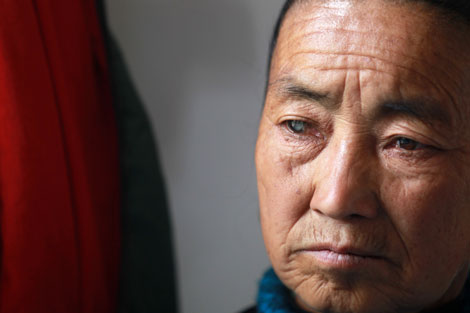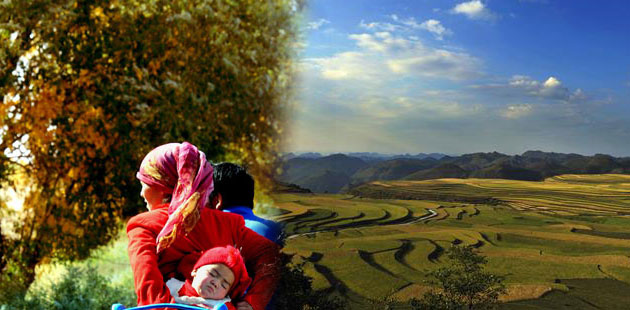Full text: White paper on rural poverty reduction
Updated: 2011-11-16 14:39
(Xinhua)
|
|||||||||
IV. Poverty Reduction by Industries
Poverty is the result of numerous factors, including historical, economic, geographic and natural ones. The Chinese government, proceeding from the actual conditions of the poverty-stricken areas, upholds the principle of comprehensive improvement, and gives full play to the advantages of related government departments to carry out poverty reduction by industries.
Promoting agricultural technology. Focusing on the specialty and competitive industries of poverty-stricken areas, the state has popularized advanced practical technologies of various types to increase the production of crop cultivation and animal, poultry and fish breeding through such means as signing of scientific and technological contracts, provision of both technological and material support, and building of demonstration models. The state also provides large-scale training in rural areas, mainly targeted at the young and middle-aged, in order to bring to the fore large numbers of good hands in farming and breeding trades, those who can lead other people to get rich, farming and animal husbandry technicians, skilled craftsmen and enterprise managerial staff badly needed for agricultural industrialization, leaders of farmers' cooperative organizations and rural agents.
Improving traffic conditions in poverty-stricken areas. Great efforts have been made to promote the construction of asphalt (cement) roads in the townships (towns) and villages that form separate administrative units to satisfy the basic needs of the poverty-stricken villagers to travel; to strengthen the renovation of unsafe road bridges and construction of safety-enhancement projects in rural areas to improve the conditions of rural highway networks and improve road safety and overall road service in rural areas; and to promote the construction of passenger terminals in townships (towns), strengthen road construction in port areas and "Red tourism" routes, and support the construction of important water-transport channels and inland waterway transport facilities that provide convenience to the local people.
Strengthening construction of water conservancy projects in poverty-stricken areas. The government has made great efforts to solve the problem of drinking water for people and livestock in impoverished rural areas, and to proactively promote the construction of safe drinking water projects there; to promote continued construction of supporting facilities and water-conservation renovation in the various irrigation areas, and to carry out the construction of small water cellars, small ponds, small reservoirs, small pumping stations and small canals, known as the "five small projects," in accordance with local conditions; if conditions are right, to build projects to divert water from water-rich areas to impoverished areas to tackle their problem of droughts and water shortages; to strengthen the construction of flood-control projects and quicken the risk-removing reinforcement of unsafe reservoirs, harnessing of medium and small rivers and repair of hydraulic projects destroyed by floods and natural disasters; and to strengthen the protection of headwaters and the prevention and control of water pollution.
Solving the problem of power supply to areas with no access to electricity. The state has mobilized resources to implement the first and second phases of the rural power grid renovation project, the project of rural power grid improvement in the central and western regions of the country, project of delivering electricity to every household, project of power grid construction in areas without access to electricity, and a new round of rural power grid renovation and upgrading projects and the project of electrification of new rural areas to enhance the reliability and capacity of rural power grids; to develop power generation with solar energy and wind power in light of local conditions to provide electricity for administrative and natural villages that have no access to electric power; promote the county-wide electrification program with power from hydropower resources under the program of building new rural areas; and strengthen the building of the technical service system of renewable energies together with the construction of rural ecological energy supplies using methane, fuel-efficient stoves and small hydropower stations to replace the use of fuels.
Rebuilding dilapidated houses in rural areas. Since 2008, the state has undertaken pilot projects to rebuild dilapidated houses in rural areas, aiming at ensuring basic housing safety for the poor in rural areas. Over the past three years, the state has earmarked in total 11.7 billion yuan of allowances to help 2,034,000 poor farmers' households rebuild unsafe houses. In 2010, the program had covered all counties in land border areas, counties in the western regions, key counties for national poverty reduction and development work, counties designated by the State Council to enjoy the preferential policies adopted for the Western Development pro-gram and regiment-level farms of the Xinjiang Production and Construction Corps.
Poverty reduction with science and technology. The state dispatches to rural areas science and technology teams composed of experts and young and middle-aged intellectuals with practical experience from universities, colleges and research institutions, and appoints scientists as resident deputy heads of key counties for poverty reduction work to help study and formulate poverty reduction plans through science and technology, select scientific and technological development programs, introduce advanced practical technologies, organize training in science and technology, solve key technological problems in industrial development, and improve the technological level of industrial development in poverty-stricken areas. The state also launches technology entrepreneurship by technological personnel in rural areas, encourages scientific and technological workers to form interest groups with farmers to start businesses and provide related services, and guides technology, information, capital, management and other modern production factors to move to impoverished areas to promote local economic and social development, and help farmers increase their incomes and achieve prosperity.
Developing social undertakings in poverty-stricken areas. The state establishes funding mechanisms for compulsory education in rural areas, and increases subsidies to students from poor families to alleviate the burden of education on impoverished areas; implements classroom renovation project for rural junior high schools in the central and western regions, schoolhouse safety project for primary and secondary schools throughout the country and renovation project of rural schools with weak facilities to enhance the construction of dormitories, canteens and other basic infrastructural facilities and improve teaching conditions; implements modern distance education in rural primary and secondary schools to ensure the sharing of high quality educational resources between urban and rural areas and among different regions; strengthens the construction of three-tier medical service system in rural areas and the construction of township hospitals and village clinics in key counties covered in the national poverty reduction and development work; implements the project that offers free training to medical students oriented to work in rural areas, with the focus on the training of medical workers to work in hospitals at and below the township level; makes greater efforts to train qualified country doctors and midwives, and encourages graduates of medical schools to work at township-level hospitals; further increases govern-mental support to new-type rural cooperative medicare system; establishes and improves population and family planning service networks; comprehensively implements the support and rewarding system for rural households which follow the family planning policies, and promotes the family planning project in the western regions with the theme "fewer children, quicker prosperity." The state also strengthens the construction of public cultural service networks in rural areas, focuses on the building of comprehensive cultural centers in townships, and organizes the implementation of the national cultural information resource sharing, books for villages, radio and TV access to every village, rural film showing and "rural community library" projects.
Strengthening ecological construction in poverty-stricken areas. The state has made efforts to consolidate the achievements of the farmland-to-forest project, improves the subsidy policy, and extends the deadline for such subsidies; has started to implement the pastureland-to-grassland project by adopting such measures as sealing off mountains and hills for natural grass growth and banning grazing to protect the vegetation cover of natural grasslands. It has launched pilot projects in Tibet Autonomous Region and other areas to subsidize people who protect the grassland ecology; organized the implementation of the Beijing and Tianjin sandstorm source control project and made efforts to develop ecological specialty industries in project areas to realize the organic integration of ecological construction and economic development. It has taken comprehensive measures to reverse the trend of desertification in Karst areas to realize the integration of industrial development and development-oriented poverty reduction by closing off hills for the growth of trees and grass, planting trees and grass, developing herbivore animal husbandry, constructing terrace-fields on sloping land and building small hydraulic and water conservation projects.
It has implemented the ecological protection and construction project at the headwaters of the Yangtze, Yellow and Lancang rivers to strengthen ecological protection in these areas through the conversion of farmland to grassland, immigration for ecological protection purpose, prevention and control of rodent damage, precipitation enhancement and other measures. The state has enhanced the ecological compensation system, and strengthened the protection of natural forests, the protection and restoration of wetlands, the conservation of wild animals and plants, and the construction of nature reserves to maintain biological diversity.
The state has included development-oriented poverty reduction schemes for ethnic minorities, women and the disabled in its planning, made unified arrangements for their implementation, given priority to their implementation when all conditions are equal, and strengthened support for these groups. It has organized the implementation of a special program to revitalize border areas and enrich the local people, given support to border areas in their efforts to speed up their economic and social development, and helped the people in border areas to increase their incomes and achieve prosperity, and the scope of the support covers all land border counties and border farms of the Xinjiang Production and Construction Corps. The total amount of money invested in this program from 2000 to 2010 reached 2.21 billion yuan. The state has rendered special support to 22 ethnic groups, each of which has a population less than 100,000, has worked out and implemented the Program to Support the Development of Ethnic Minorities with Small Populations (2005-2010), and allocated 3.751 billion yuan in support of these smaller ethnic groups and the areas where they live in compact communities to help quicken their development. The state has organized the implementation of the Program for the Development of Chinese Women (2001-2010), prioritized poverty reduction for women and the reduction of the number of impoverished women, strengthened support to women in poverty, helped and supported impoverished women to start poverty reduction programs, and encouraged and supported the development of poverty reduction economic entities with women as the focus. Since 2009, the state has also organized the implementation of programs of interest-discount small-sum loans with guaranty. By the end of July 2011, it had issued a total of 40.993 billion yuan in such loans, including 25.923 billion yuan for women in rural areas, which has ensured impoverished women' s access to poverty reduction resources and made them direct beneficiaries of poverty reduction achievements. The state has also implemented the Development-oriented Poverty Reduction Program for Disabled People in Rural Areas (2001-2010), determining poverty reduction pro-grams and methods in accordance with the characteristics of disabled people and local conditions, with primary attention being paid to solving the problem of sufficient food and clothing for disabled people in poverty and bridging the gap between the living standard of the disabled people and that of the general public.











